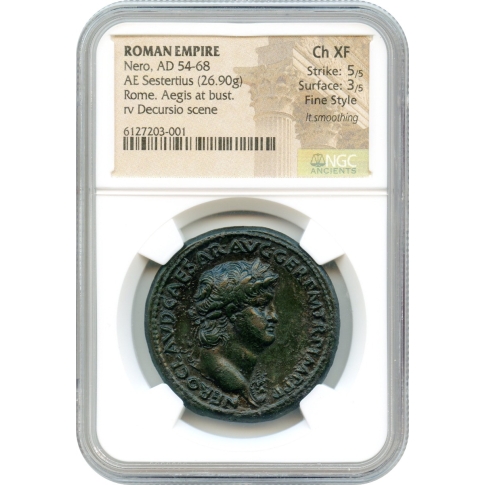Ancient Rome - 54-68 CE Nero AE Sestertius NGC Choice XF Fine Style
Nero, as Augustus, AE sestertius (38 mm, 26.86 gm). Struck in Fine Style at the Lugdunum mint, circa AD 64-65. The obverse features NERO•CLAVD•CAESAR•AVG• GER•P M TR P IMP P around, with the laureated head of Nero facing right, a globe at point of truncation. The reverse features DECVRSIO in exergue, with Nero featured above and on horseback riding left, couched spear in his left hand, and a soldier on horseback riding right alongside, with vexillum in right hand over shoulder, S-C across fields. The exhibit a rich, chocolate brown with a great deal of reflectivity on both sides. The obverse is exceptionally well-centered while the reverse is ever-so slightly off center. We believe the light "smoothing" referenced on the NGC insert applies to the reverse upper left field, in and around the discoloration, although it's really difficult to tell. Provenance: LHS Sale #95 on October 25, 2005: 775.
"Decursio, Decursus, Decurrere." These words were used to signify the maneuvers of the Roman army, by which the soldiers were taught to make long marches in a given time, under arms and without quitting their ranks. With the standing armies under the empire these maneuvers assumed a more regular form and were constantly practiced. Augustus and subsequently Hadrian ordered that the infantry and cavalry were to march ten miles out from the camp and ten miles back fully armed and equipped, three times a month. The same words were used to signify the military honors paid by soldiers at the funeral of distinguished generals or emperors. The decursio, which occurs on the coins of Nero, probably refers to the military maneuvers or sham fights in the circus. These games date from the time of the republic and were continued under the empire." (Liv. 44.9, 3) (Dictionary of Greek and Roman Antiquities, London 1890).
Considered the most infamous Roman Emperor, Nero Claudius Caesar (37-68 CE) ruled the Roman Empire from 54 CE until he took his own life some 14 years later. His infamy lay in his political assassinations, debaucheries, persecution of Christians, and his burning passion for music. Born Lucius Domitius Ahenobarbus, Nero took his famous name when his great-uncle, the emperor Claudius, adopted him. He took the throne after the death of Claudius. Nero spent much energy during his reign upon diplomacy, developing trade, and improving the cultural life of Rome. According to the historian Tacitus, however, the people of Rome saw him as compulsive and corrupt.
Nero was under the shadow of this domineering mother. When he attempted to break away from her control, she turned against him and declared her stepson to be the rightful heir to the throne. That resulted in Brittanicus dying under dubious circumstances, and later Nero had his own mother stabbed to death in her villa. A massive fire destroyed three of Rome's 14 districts and seven more of them were gutted by fire. Classical sources say that Nero was found on the roof of his palace during the fire, clothed in stage costume while singing from the Greek epic, "The Sack of Ilium." Rumors spread that Nero had personally started the fire to clear land to expand his palace complex on the Palatine Hill. In order to deflect blame from himself, Nero made Christians the scapegoat for the fire, and had them brutally and creatively murdered. Some were dressed in animal skins and torn to shreds by dogs, while others were burned in nighttime pyres that lit up the emperor's garden parties.
| Grading Service | NGC |
|---|---|
| Year of Issue | NONE |
| Grade | XF45 |
| Ancient Year Range | 1-100 AD |
| Denom Type | Ancient |
| Numeric Denomination | AE Sestertius |
| Mint Location | NONE |
| Designation | NONE |
| Circ/UnCirc | Circulated |
| Strike Type | Business |
| Holder Variety | Strike 5/5; Surface 3/5. Struck in Fine Style |
| Grade Add On | NONE |
| Holder Type | N/A |



